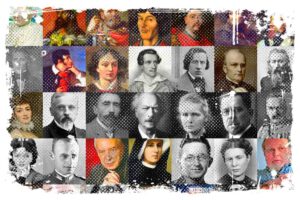Throughout the history of our country, there are many notable figures who have made significant contributions to both our nation and the world. These individuals have helped shape our understanding of science and have also had a major impact on various aspects of our daily lives. Here are just a few examples of the incredible Polish scientists who have left their mark on history:

Jan Czochralski (1885-1953)
It’s hard to imagine life without computers, TVs, smartphones, and other electronic devices that have become so integral to our daily routines. But we have Polish scientist Jan Czochralski to thank for making these technological improvements possible. In 1916, Czochralski developed the „Czochralski Method”, a technique for measuring the rate of crystallization in metals. This method is now used to produce monocrystals, which are the foundation for microprocessors production.
Czochralski, who didn’t even have a high school diploma, made this groundbreaking discovery by accident while taking notes in his laboratory. He accidentally dipped the tip of his pen into a bowl with molten tin, resulting in the formation of a rod of solidified metal – tin crystal. While this was Czochralski’s most significant achievement, he also made other important contributions. They included creating a „metal B” that revolutionized railroads.
Jan Szczepanik (1872-1926)
Did you know that television was also invented by a Polish scientist? In 1897, Jan Szczepanik invented the telectroscope, a device that allowed for the transmission of moving color images and sound over a distance. Szczepanik’s first film was a recording of surgery at Langbeck-Virchov Hospital. In addition to this groundbreaking achievement, he also developed a color film system, color photography, and film with sound.
↳ PRO TIP: Do you like traveling? Then before you buy any ticket or book an attraction, check if it's available in this worldwide Viator Database. You may save a lot of money and time. No need to thank me :)
Szczepanik even collaborated with Kazimierz Żeglen to create a bulletproof vest that saved the life of King Alfonso XIII in Spain during his assassination attempt. This polish scientist had over 50 inventions and hundreds of technical ideas to his credit, earning him worldwide fame and comparisons to both Edison and da Vinci. In fact, Szczepanik’s work was even featured in articles written by Mark Twain, with whom they were friends.
Jacek Karpiński (1927-2010)
Krystian Karpinski was a brilliant scientist who created the world’s first personal computer, the K-202 minicomputer. It was a decade ahead of its competitors. In 1969, when computers took up the space of entire rooms, Karpinski designed a device the size of a suitcase that was faster, more powerful, and multitasking than even the first IBM PCs that were released a few years later.
His inventions attracted English investors who were willing to produce it, but Karpinski refused to move it abroad for patriotic reasons. Unfortunately, the communist authorities in Poland blocked the production of the K-202, allegedly supporting the creators of the Odra 1240 instead. Karpinski’s inventions were also not supported for ideological reasons, as he participated in the Warsaw Uprising.
In addition to the K-202 minicomputer, Krystian Karpinski also developed a machine that could predict long-term weather forecasts and a device that analyzed differential equations. Despite these successes, Karpinski faced a number of failures and eventually he became a farmer. Finally, he decided to move to Switzerland where he designed a voice-controlled robot and PenReader, a scanner for reading text.
Unfortunately, these projects were not developed due to financial reasons. In 1990, Karpinski returned to Poland and worked as an advisor to Ministers Andrzej Olechowski and Leszek Balcerowicz. In the later years of his life, he was also involved in the design of a speech recognition and recording software.
Stanisław Ulam (1909-1984)
After Professor Kuratowski noticed his exceptional talent, he became a member of the Lviv School of Mathematics, working closely with mathematicians such as Stefan Banach, Stanislaw Mazur, and others to solve complex mathematical problems at the Scottish Café.
He received his doctorate in mathematics from the Lviv Polytechnic. He gave lectures and participate in scientific presentations throughout Europe. In 1935, he was offered a scholarship at Princeton, and a year later he began working at Harvard University. Eventually, before the outbreak of World War II he settled permanently in the United States.
During the war, he wanted to contribute to the technological support of the Allied victory and ended up at the Los Alamos nuclear research center. He was involved in the top-secret Manhattan Project to build a hydrogen (thermonuclear) bomb. Together with a group of other scientists, he proved the original idea for building the bomb, proposed by Edvard Teller, was incorrect and developed the weapon’s final mechanism known as the „Teller-Ulama device”.
In addition to his work on the bomb, he made significant contributions to topology, measure theory, multiplicity, probability, and other processes through his 150 published works. He was also a member of President Kennedy’s scientific advisory committee and served on committees for NASA and the US Air Force.
Józef Hofmann (1876-1957)
He was a renowned pianist who gave concerts in many European countries and the United States from a young age. With the help of Thomas Edison, he became the first professional musician to record his music in 1887, using a wax roller. In addition to his artistic talent, he was also an inventor, designing over 70 inventions.
Many of these were intended for musicians playing the piano, but he also created practical items that are still in use today, such as car springs, windshield wipers (which he supposedly modeled after a metronome), a shock absorber, and a paper clip.
Napoleon Cybulski (1854-1919)
The founder of endocrinology, Napoleon Cybulski made a significant contribution to medicine with his discovery of adrenaline, which he isolated together with his student Wladyslaw Szymonowicz. Cybulski also developed other branches of knowledge, including a device to measure the rate of blood flow in the arteries (photohemotachometer) and conducted experiments with Adolf Beck to study the electrical activity of the brain and its relationship to fatigue or anesthesia.
These experiments formed the basis for the development of electroencephalography, which is now used for the diagnosis of epilepsy and brain tumors, among other things. Cybulski also examined muscle and nerve electrophysiology and was the first Pole to record the electrical activity of the heart in 1910. He was also interested in hypnotism and published around 100 papers. Cybulski was nominated for the Nobel Prize three times, in 1911, 1914, and 1918.
Hilary Koprowski (1916-2013)
Hilary Koprowski developed the world’s first oral vaccine against the polio virus, which causes poliomyelitis. The first successful unit vaccination was carried out in 1950, and the method was soon implemented nationwide in the Belgian Congo, Rwanda, Poland, and Croatia. In the 1950s, an epidemic of the disease broke out, with as many as 6,000 children in Poland contracting the disease at its peak in 1958.
The following year, thanks to Koprowski’s donation of 9 million vaccines produced by the Wyeth pharmaceutical company, the disease was almost completely eradicated in Poland and then throughout Europe due to subsequent vaccinations.
Koprowski was a scientist who wrote over 850 scientific papers and conducting research on virology and immunology, including the use of immunotherapy in cancer treatment. He also established the Koprowski Foundation, which supports young Polish scientists and promotes Polish-American cooperation in science. In addition to his scientific pursuits, Koprowski was also interested in music and literature.
Kazimierz Funk (1884-1967)
While researching the cause of beri-beri disease in 1912, the scientist isolated a compound from rice bran that was later identified as the first vitamin – B1. He named it after the Latin words „vita,” meaning life, and „amine,” referring to nitrogen-containing compounds, and is considered the founder of vitaminology. In his later years, he treated patients with avitaminosis, and his discovery had a significant impact on fields including oncology and diabetology, changing our understanding of healthy eating habits. He was nominated for a Nobel Prize and also conducted research on hormones and cancer.
Kazimierz Prószyński (1875-1945)
In the early 1900s, Proszynski created a machine called the pleograph that could display films and take photographs. This device could take about 50 pictures per second, which was faster than similar machines at the time. Proszynski tried to improve his invention, but the Lumiere brothers beat him to the patent and are now known as the fathers of cinema. Despite this, Proszynski continued to work on improving cinematographic technology and developed a system to stop flickering and shaking in films. He also tried to transmit images over a distance and made the telephotograph, which was meant to be a prototype for television. However, this invention was not successful because it was too complex.
Prószynski’s most important achievement was the creation of the first hand-held film camera, the aeroscope, in 1909. This portable camera changed the film industry and made it easier for operators to take pictures anywhere and at any time. The aeroscope was used to record World War I. Proszynski also made the „autolektor”, a device for recording texts for blind people, and the „cinephone”, the first machine that could play sound and images at the same time. Proszynski died in a concentration camp in 1945.
Kazimierz Siemienowicz (ok. 1600-1651)
Siemienowicz wrote „The Great Art of Artillery Part One” in 1650, which became a major textbook on the art of war for the next two centuries. In this book, he gathered all the known information about artillery at the time and also included innovative ideas and techniques he discovered through his own experiments. He may have been the first person to design a rocket, including a multi-stage and multi-head rocket, and a rocket battery.
He also talked about using delta-shaped wings, which are still used today. His work influenced the development of artillery, but wasn’t published in Polish until 1963. It is believed that Siemienowicz was working on a second part of his book, but it and its creator have been lost. It is not known what happened to him after 1651. Some sources say he was killed by pyrotechnicians.
Bibliography
- https://pl.wikipedia.org/wiki/Jan_Czochralski
- https://pl.wikipedia.org/wiki/Jan_Szczepanik
- https://pl.wikipedia.org/wiki/Jacek_Karpi%C5%84ski
- https://pl.wikipedia.org/wiki/Stanis%C5%82aw_Ulam
- https://pl.wikipedia.org/wiki/J%C3%B3zef_Hofmann
- https://pl.wikipedia.org/wiki/Napoleon_Cybulski
- https://pl.wikipedia.org/wiki/Hilary_Koprowski
- https://pl.wikipedia.org/wiki/Kazimierz_Funk
- https://pl.wikipedia.org/wiki/Kazimierz_Pr%C3%B3szy%C5%84ski
- https://pl.wikipedia.org/wiki/Kazimierz_Siemienowicz




